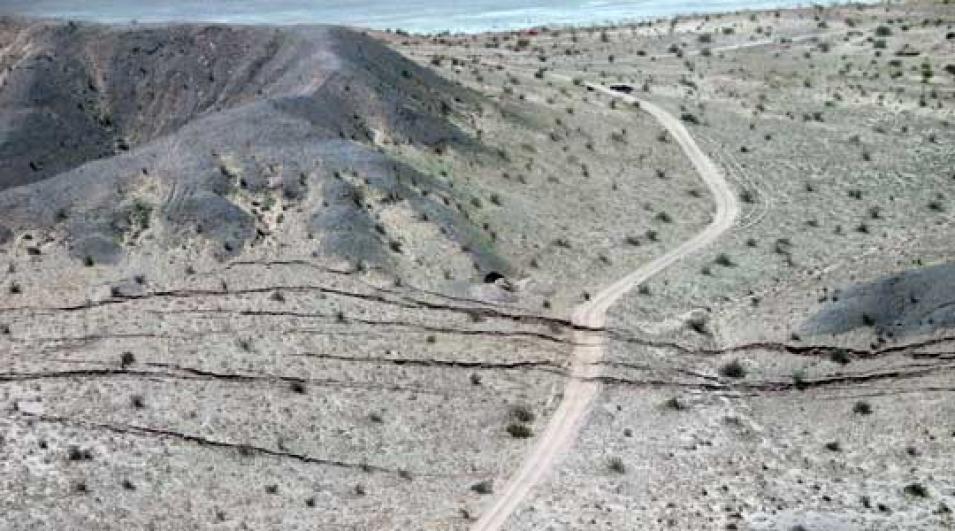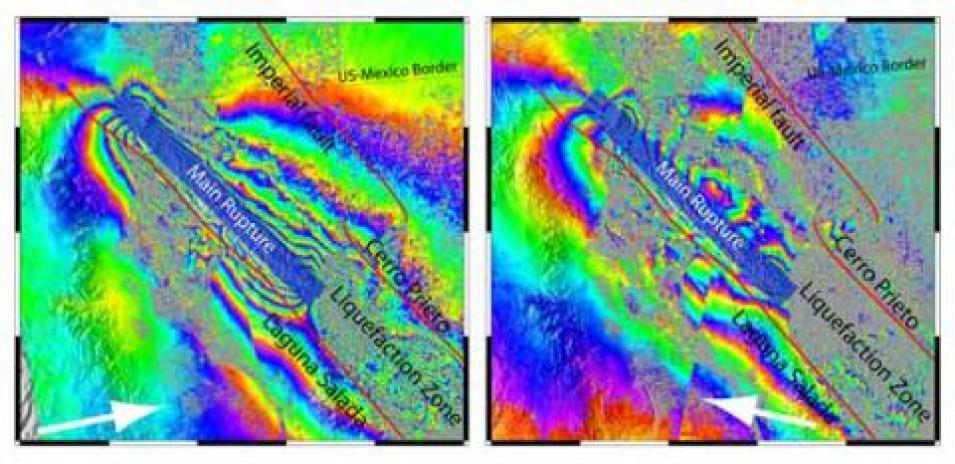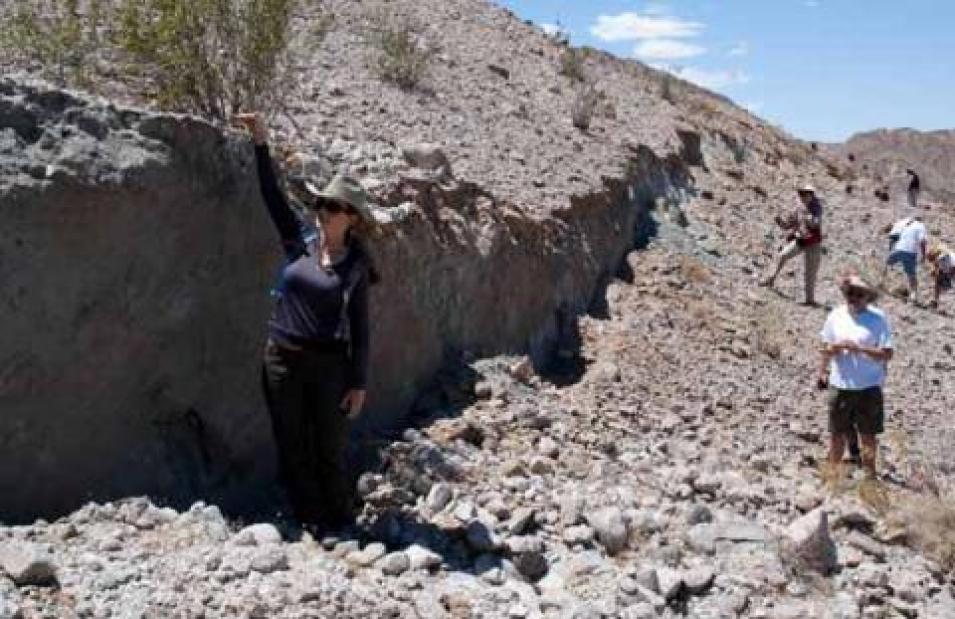Many people who live near California’s San Andreas Fault anticipate the “big one,” a massive earthquake that could leave behind severe and long-lasting devastation. Geologists who study the region say that the big one could come at any time, so they are constantly trying to learn more about the underlying faults to understand when and where large earthquakes are most likely to happen. Yet even as researchers scout the San Andreas and other major faults for evidence that the big one is pending, it is the smaller faults that are acting up, producing large earthquakes where scientists do not expect them.
Baja's Fault
The April 2010 El Mayor-Cucapah earthquake revealed a previously undiscovered fault in the desert of Baja California, Mexico. Although the fault is relatively small, it produced a magnitude 7.2 earthquake. Scientists have become interested in smaller faults, because they are frequently the location of unexpectedly large earthquakes. (Courtesy T. Fletcher)
One of those unexpected earthquakes rattled remote portions of southern California and Mexico’s Baja California on April 4, 2010. The El Mayor-Cucapah earthquake caused extensive damage to the city of Mexicali, displacing more than 35,000 people and demolishing the surrounding agricultural areas along with the roads and irrigation channels leading to them. Similarly, two previous earthquakes in southern California, the 1992 Landers earthquake that severely damaged the town of Landers, and the 1999 Hector Mine earthquake that shook a Marine Corps Base in the Mojave Desert, occurred on relatively small faults.
“None of the main ruptures in the last forty years have occurred on the most active faults of the San Andreas system,” said David Sandwell, a researcher with the Scripps Institute of Oceanography. While the San Andreas Fault bears watching, Sandwell and other scientists are learning that the more numerous, smaller faults may be just as active, with the potential to be as destructive.
Imperial implications
Faults are large fractures in the Earth’s crust where massive slabs of solid rock, called tectonic plates, run into each other, grind past each other, or pull apart. An earthquake often results from a sudden release of the tremendous stress that builds up along the boundaries of these slow-motion collisions. The entire Pacific coast of the United States straddles dozens of faults, including the famous San Andreas Fault that runs for 1,300 kilometers (810 miles) through California. Nearly all of California’s thirty-seven million residents live on or near faults. Severe earthquakes could lay waste to large cities like Los Angeles and San Francisco, but even earthquakes in remote or sparsely populated regions may cause significant damage, especially when they occur in agricultural areas.
Although few people were killed in the El Mayor-Cucapah earthquake, it ravaged a large swath of fertile farmland in Baja California, wiping out the infrastructure Mexican farmers needed to access and irrigate their crops. Scientists in the United States watched closely, because California’s Imperial Valley, a major producer of fruit, vegetables, and grains, lies just north of the earthquake-devastated area. “The Imperial Fault goes through all the agricultural zones in the Imperial Valley. They use exactly the same kind of water delivery systems, and have the same kind of farms,” Sandwell said. “All of that could get destroyed in a similar earthquake and be a huge economic setback.”
An unknown fault
Immediately after the El Mayor-Cucapah earthquake, scientists set out to find the fault that may have caused it. They suspected that the earthquake originated on one of two faults, the Cerro Prieto Fault or the Laguna Salida Fault, because the earthquake was centered between the two.
After the El Mayor-Cucapah earthquake, scientists compared ascending (left) and descending (right) tracks from Synthetic Aperture Radar satellite images from the Advanced Land Observing Satellite to map how the land surface changed. The rupture did not occur on any of the region’s three main faults, indicated by red lines. When scientists looked at where the most earthquake displacement happened, they discovered a previously unknown fault in Mexico’s Cucapah Mountains, indicated by the blue shaded area. (Courtesy M. Wei and D. Sandwell)
North of the border, scientists retrieved data about how the land had shifted from nearly a thousand Global Positioning Satellite (GPS) receivers installed across California. However, the earthquake was most destructive in Mexico, where there was only one GPS receiver. GPS receivers are so position-sensitive that when fixed to the ground, they can record even the most minute ground movement, allowing scientists to see how the land may have shifted and deformed after an earthquake. So Sandwell and one of his students, Matt Wei, now a postdoctoral researcher at the Woods Hole Oceanographic Institution, turned to satellite data to map the earthquake’s destruction and pinpoint the best locations to install more GPS receivers.
Wei and Sandwell turned to an archive of Synthetic Aperture Radar (SAR) data at NASA's Alaska Satellite Facility Distributed Active Archive Center (ASF DAAC). Using the data, from the Japan Aerospace Exploration Agency Advanced Land Observing Satellite (ALOS) Phased Array type L-band SAR (PALSAR) sensor, they overlaid the before and after SAR images of the earthquake to create interferograms, which color-code the degree to which the images do not match up. This technique, called Interferometric synthetic-aperture radar (InSAR), exposed exactly where the ground had shifted, lifted, or sunk after the earthquake. Wei said, “The advantage of InSAR is that you can use it to study earthquakes when there are no other instruments on the ground.” By analyzing the resulting interferogram, the researchers could map how much the land had deformed, accurate to within centimeters. Sandwell said, “Without the InSAR data we would know very little about this earthquake, because we didn’t have GPS data. That’s why we need a satellite to help us map earthquakes better.”
The resulting InSAR maps helped field scientists searching for the fault to navigate the rugged mountain terrain. “Field geologists took the InSAR maps and knew exactly where to go in the field to measure the fault lines,” said Sandwell. As Mexican researchers followed the fault lines and examined the freshly fractured landscape, they realized they were tracing neither of the suspected faults. They had discovered an entirely new one.
This new fault, named the Indiviso Fault after the nearby Mexican town of El Indiviso, provides scientists a piece of California’s tectonic puzzle. “The fault that caused the El Mayor-Cucapah earthquake was not where anyone expected a fault,” Sandwell said. “The faults that have the high slip rates are where you’d expect all the big earthquakes. But that’s not where we’ve had the big earthquakes over the last forty years. That’s sort of scary,” Sandwell said.
Liquefied land
Although much of the previously unmapped fault runs through sparsely populated mountains, the earthquake rupture of the Indiviso Fault extended across the agricultural plain below. The earthquake rumpled the carefully constructed network of irrigation channels and heaved once-flat roads and fields into rollercoaster-like undulations. In most of the fields, the earthquake’s shaking had been so intense that the soil liquefied and welled up like water. Wei said, “With liquefaction, the soil behaves like a fluid. Liquefaction filled the concrete-lined channels that deliver water. You could see whole channels filled with sand.”
It will not be easy for the farms around Mexicali to recover from the earthquake. “It takes a lot of time and money to repair these things,” said Wei. “You have to rebuild the channels and fix the roads.” After the roads are repaired and farmers can reach their fields, they still have the arduous task of leveling the land and reconstructing the waterways that will irrigate their crops again.
Like the Indiviso Fault, the Imperial Fault runs through a large zone of irrigated farmland. A major earthquake in the Imperial Valley could similarly devastate southern California agriculture, which accounts for nearly half of the jobs in the region and produces more than one billion dollars worth of crops annually. Even in sparsely populated areas, an earthquake’s economic damage can be extensive. While most researchers still believe that the big one will occur somewhere along the San Andreas Fault, El Mayor-Cucapah and other recent earthquakes caused by smaller faults are causing scientists to take a fresh look at risks along the entire Pacific Coast.
References
Wei, M. and D. Sandwell. 2010. The M7.2 El Major-Cucapa Earthquake in Baja California: extensive liquefaction identified in ALOS InSAR data. Alaska Satellite Facility News & Notes 6(4):2-4.
Wei, M., D. T. Sandwell, Y. Fialko, and R. Bilham. 2011. Slip on faults in the Imperial Valley triggered by the 4 April 2010 Mw 7.2 El Mayor-Cucapah earthquake revealed by InSAR. Geophysical Research Letters 38, L01308, doi:10.1029/2010GL045235.
Wei, M., D. Sandwell, and B. Smith-Kontner. 2010. Optimal combination of InSAR and GPS for measuring interseismic crustal deformation. Advances in Space Research 46:236-249.
For more information
NASA Alaska Satellite Facility Distributed Active Archive Center (ASF DAAC)
Advanced Land Observing Satellite (ALOS)
| About the remote sensing data used | |
| Satellite | Japan Space Agency Advanced Land Observing Satellite (ALOS) |
| Sensor | Phased Array Type L-band Synthetic Aperture Radar (PALSAR) |
| Data sets | PALSAR Level 1.0 |
| Resolution | Approximately 20 meters |
| Parameter | Land surface, topography |
| DAAC | NASA Alaska Satellite Facility Distributed Active Archive Center (ASF DAAC) |
Photograph in title graphic shows scientists investigating a fault rupture caused by the El Mayor-Cucapah earthquake (Courtesy C. Crosby)


